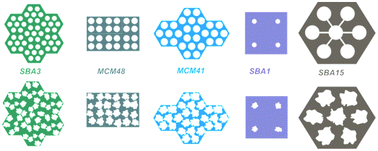The stability of various structured mesoporous materials (SBA-1, SBA-3, SBA-15, MCM-41, MCM-48) was tested under acidic stress in order to understand the mechanism of their alteration. The native materials and the materials resulting from acidic attack under various conditions were analysed by small angle X-ray scattering coupled with nitrogen adsorption and solid 29Si NMR. Among three acid media (HCl, H2SO4, H3PO4) at similar ionic strength, we focused particularly on phosphoric acid, which proved to have the strongest impact on the starting materials. The results are discussed by correlating the wall thickness and pore diameter values with regard to stability. In particular, the alteration kinetics were interpreted for the case of SBA-15 in the following scenario: the micropores were first damaged by the acidic stress, and then the mesopores were partially collapsed or partially blocked. We show that a material's resistance against acidic media is linked to a critical wall thickness–pore diameter threshold.

You have access to this article
 Please wait while we load your content...
Something went wrong. Try again?
Please wait while we load your content...
Something went wrong. Try again?


 Please wait while we load your content...
Please wait while we load your content...